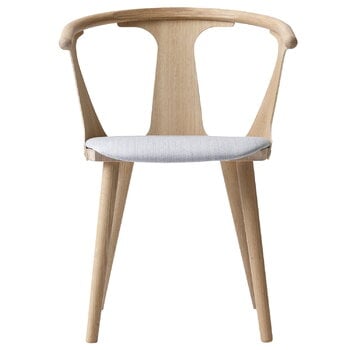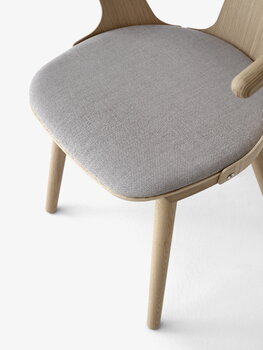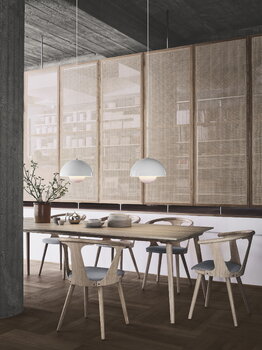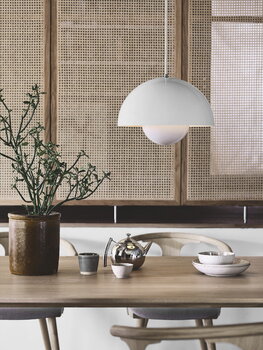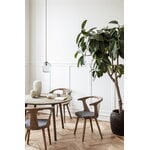In Between SK2 chair, designed by Sami Kallio for &Tradition, is defined by the gaps in the crescent-shaped back and armrest. The shape of the wood veneer panels also gives the chair its name: In Between. Made of white-oiled oak with an upholstered seat, In Between SK2 is an exercise in wood craftsmanship. Traditional techniques, such as compression moulding and woodturning, are used to achieve its form. The shape of the chair is light and balanced, and it is suitable for various spaces and rooms.
In Between SK2 chair, oiled oak - Fiord 251
&Tradition
Description
In Between SK2 chair, designed by Sami Kallio for &Tradition, is defined by the gaps in the crescent-shaped back and armrest. The shape of the wood veneer panels also gives the chair its name: In Between. Made of white-oiled oak with an upholstered seat, In Between SK2 is an exercise in wood craftsmanship. Traditional techniques, such as compression moulding and woodturning, are used to achieve its form. The shape of the chair is light and balanced, and it is suitable for various spaces and rooms.
Product details (14)
- Colour
- Oiled oak, grey
- Width
- 58 cm
- Depth
- 54 cm
- Height
- 77 cm
- Seat height
- 45 cm
- Frame material
- Oiled oak, form pressed veneer
- Seat cushion
- CMHR foam
- Upholstery fabric
- Kvadrat: Fiord 0251, 92% new wool (worsted), 8% Nylon
- Abrasion resistance
- 60,000 Martindale
- Pilling
- 4-5
- Lightfastness
- 6
- Weight
- 7 kg
- Stackable
- No
- Notes
- Comes with felt glides installed as standard.
- Product ID
Designer
Sami Kallio (born 1975 in Helsinki, Finland) lives and works as a freelance designer in Gothenburg, Sweden. Kallio has said that his work combines the melancholy of the Finnish design heritage with the humour of the Swedish tradition. He graduated from the School of Design and Crafts in Gothenburg in 2005. Kallio has taken part in numerous exhibitions, and the furniture collection called The Finnish Blood In Me that was presented in Stockholm Furniture fair in 2011 caught a lot of attention.
View all productsReviews (1)
4
Based on 1 reviews
-
J
J.H. Y
Rotterdam, Netherlands
I liked the oiled surface and a very pretty design. One little thing is the chair is rather on the bulky side due to its seat depth, taking up more space than other chairs.
377 days ago
Sustainability
The Product Sustainability Framework, our criteria of sustainable design, helps you find the most sustainable products in our selection. Read below which sustainability criteria this product has met.
Working conditions & labour 8/9
-
Equal opportunities for all employees
-
Commitment to UN Global Compact, fair compensation for all employees
-
Corporate responsibility requirements defined and communicated for suppliers
-
Systematic work for improved inclusion and well-being in the workplace
-
Transparent supply chain
-
Suppliers' compliance to a code of conduct ensured
-
Direct suppliers audited and certified
-
Compliance to the UN Guiding Principles on Business and Human Rights ensured in the supply chain
Eco-friendly production 6/9
-
Fair and resource-wise water-use in production
-
No incineration or landfilling of returned items
-
No use of endangered species as materials
-
No direct environmental emissions or waste (excl. GHGs) from production
-
Material-efficient and ecological packaging
-
No potentially harmful chemicals used in own production
Climate impact 5/8
-
Company's direct greenhouse gas emissions identified and commitment to reduction
-
Product's carbon impact identified and commitment to reduction
-
Guidance on energy- and eco-efficient use of the product
-
Contribution to climate initiatives beyond the brand’s direct operations
-
100 % renewable energy in own production and operations
Sustainable materials 4/6
-
Sustainable and long-lasting material choices
-
No harmful or hazardous substances
-
Responsible raw material sourcing and production
-
Ecological materials: natural, biodegradable, recyclable or recycled contents
Circular design 4/5
-
High aesthetic quality promoting long-term use of the product
-
Technically durable product design and material choices
-
Design for enduring life-long quality
-
Design and support for product maintenance, repair and upgradability

